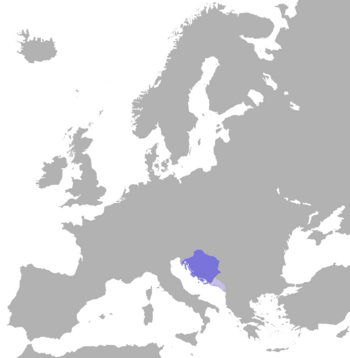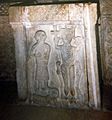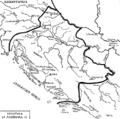Kingdom of Croatia (medieval) facts for kids
Quick facts for kids
Kingdom of Croatia
Kraljevina Hrvatska
|
|||||||||||
|---|---|---|---|---|---|---|---|---|---|---|---|
| c. 925–1102 | |||||||||||

Croatia at the height of its power
|
|||||||||||
| Capital | Varied through time Nin Biograd Solin Knin |
||||||||||
| Common languages | Old Croatian, Latin | ||||||||||
| Religion | Roman Catholicism | ||||||||||
| Government | Feudal Monarchy | ||||||||||
| King | |||||||||||
|
• 925–928
|
Tomislav (first) | ||||||||||
|
• 1093–1097
|
Petar Svačić (last) | ||||||||||
| Ban (Viceroy) | |||||||||||
|
• c. 949–969
|
Pribina (first) | ||||||||||
|
• c. 1075–1091
|
Petar Svačić (last) | ||||||||||
| Historical era | Middle Ages | ||||||||||
|
• Elevation to kingdom
|
c. 925 | ||||||||||
| 1102 | |||||||||||
| Area | |||||||||||
| 110,000 km2 (42,000 sq mi) | |||||||||||
| ISO 3166 code | HR | ||||||||||
|
|||||||||||
The Kingdom of Croatia, or Croatian Kingdom, was a medieval kingdom in Central Europe comprising most of what is today Croatia, as well as most of the modern-day Bosnia and Herzegovina. Part of the Croatian Kingdom period ruled by ethnic dynasties, the Kingdom existed as a sovereign state for nearly two centuries.
The Slavs arrived in the early 7th century in what is Croatia today. No contemporary written records about the migration have been preserved, especially not about the events as a whole and from the area itself. Instead, historians rely on records written several centuries after the facts, and even those records may be based on oral tradition.
The Croats were a Slavic tribe, coming from an area in and around today's Poland or western Ukraine. Many modern scholars believe that the early Croat people, as well as other early Slavic groups, were agricultural populations that were ruled by the nomadic Iranian-speaking Alans.
Its existence was characterized by various conflicts and periods of peace or alliance with the Bulgarians, Byzantines, Hungarians, and competition with Venice for control over the eastern Adriatic coast. The goal of promoting the Croatian language in the religious service was initially brought and introduced by the 10th century bishop Gregory of Nin, which resulted in a conflict with the Pope.
In the second half of the 11th century Croatia managed to secure most coastal cities of Dalmatia with the collapse of Byzantine control over them. During this time the kingdom reached its peak under the rule of kings Peter Krešimir IV (1058–1074) and Demetrius Zvonimir (1075–1089).
The state was ruled mostly by the Trpimirović dynasty until 1091. At that point the realm experienced a succession crisis and after a decade of conflicts for the throne and the aftermath of the Battle of Gvozd Mountain, the crown passed to the Árpád dynasty with the coronation of King Coloman of Hungary as "King of Croatia and Dalmatia" in Biograd in 1102, uniting the two kingdoms under one crown.
Images for kids
-
Croatia on a map of southeastern Europe in 1045
See also
 In Spanish: Reino de Croacia para niños
In Spanish: Reino de Croacia para niños









